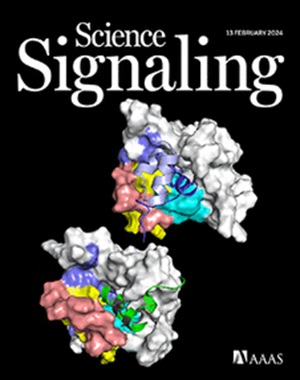USP5去泛素化并稳定FcεRIγ以增强ige诱导的肥大细胞活化和过敏性炎症
IF 6.6
1区 生物学
Q1 BIOCHEMISTRY & MOLECULAR BIOLOGY
引用次数: 0
摘要
免疫球蛋白E (IgE)与高亲和力IgE受体(FcεRI)结合,抗原介导的聚集引发肥大细胞活化和过敏性炎症。在此,我们研究了泛素特异性蛋白酶5 (USP5)在ige介导的肥大细胞活化及其对FcεRIγ稳定性的调节中的作用。我们发现,USP5敲低抑制了ige诱导的肥大细胞β-己糖氨酸酶和组胺的释放,减轻了小鼠的过敏性炎症。USP5与肥大细胞中的FcεRIγ相互作用,导致其去泛素化和稳定。此外,USP5逆转了k48连接的FcεRIγ多泛素化。肥大细胞或HEK293T细胞中USP5的敲低增加了E3泛素连接酶ccl -b与FcεRIγ的结合,导致FcεRIγ多泛素化和降解增加。USP5抑制剂WP1130在小鼠中减弱ige介导的肥大细胞活化和过敏性炎症。总之,这些发现描述了usp5介导的肥大细胞中FcεRIγ稳定性调控的分子机制,并确定了USP5-FcεRIγ轴作为治疗IgE/ fcε ri介导的变应性疾病的潜在药物靶点。本文章由计算机程序翻译,如有差异,请以英文原文为准。
USP5 deubiquitylates and stabilizes FcεRIγ to enhance IgE-induced mast cell activation and allergic inflammation
Antigen-mediated aggregation of immunoglobulin E (IgE) bound to the high-affinity IgE receptor (FcεRI) initiates mast cell activation and allergic inflammation. Here, we investigated the role of ubiquitin-specific protease 5 (USP5) in IgE-mediated mast cell activation and its regulation of FcεRIγ stability. We found that USP5 knockdown inhibited the IgE-induced release of β-hexosaminidase and histamine from mast cells and attenuated allergic inflammation in mice. USP5 interacted with FcεRIγ in mast cells, leading to its deubiquitylation and stabilization. In addition, USP5 reversed the K48-linked polyubiquitylation of FcεRIγ. USP5 knockdown in mast cells or HEK293T cells increased the binding of the E3 ubiquitin ligase Cbl-b to FcεRIγ, leading to an increase in FcεRIγ polyubiquitylation and degradation. The USP5 inhibitor WP1130 attenuated IgE-mediated mast cell activation and allergic inflammation in mice. Together, these findings describe the molecular mechanism of USP5-mediated regulation of FcεRIγ stability in mast cells and identify the USP5-FcεRIγ axis as a potential drug target for the therapy of IgE/FcεRI-mediated allergic diseases.
求助全文
通过发布文献求助,成功后即可免费获取论文全文。
去求助
来源期刊

Science Signaling
BIOCHEMISTRY & MOLECULAR BIOLOGY-CELL BIOLOGY
CiteScore
9.50
自引率
0.00%
发文量
148
审稿时长
3-8 weeks
期刊介绍:
"Science Signaling" is a reputable, peer-reviewed journal dedicated to the exploration of cell communication mechanisms, offering a comprehensive view of the intricate processes that govern cellular regulation. This journal, published weekly online by the American Association for the Advancement of Science (AAAS), is a go-to resource for the latest research in cell signaling and its various facets.
The journal's scope encompasses a broad range of topics, including the study of signaling networks, synthetic biology, systems biology, and the application of these findings in drug discovery. It also delves into the computational and modeling aspects of regulatory pathways, providing insights into how cells communicate and respond to their environment.
In addition to publishing full-length articles that report on groundbreaking research, "Science Signaling" also features reviews that synthesize current knowledge in the field, focus articles that highlight specific areas of interest, and editor-written highlights that draw attention to particularly significant studies. This mix of content ensures that the journal serves as a valuable resource for both researchers and professionals looking to stay abreast of the latest advancements in cell communication science.
 求助内容:
求助内容: 应助结果提醒方式:
应助结果提醒方式:


